Pei Fu
HyperClick: Advancing Reliable GUI Grounding via Uncertainty Calibration
Oct 31, 2025Abstract:Autonomous Graphical User Interface (GUI) agents rely on accurate GUI grounding, which maps language instructions to on-screen coordinates, to execute user commands. However, current models, whether trained via supervised fine-tuning (SFT) or reinforcement fine-tuning (RFT), lack self-awareness of their capability boundaries, leading to overconfidence and unreliable predictions. We first systematically evaluate probabilistic and verbalized confidence in general and GUI-specific models, revealing a misalignment between confidence and actual accuracy, which is particularly critical in dynamic GUI automation tasks, where single errors can cause task failure. To address this, we propose HyperClick, a novel framework that enhances reliable GUI grounding through uncertainty calibration. HyperClick introduces a dual reward mechanism, combining a binary reward for correct actions with a truncated Gaussian-based spatial confidence modeling, calibrated using the Brier score. This approach jointly optimizes grounding accuracy and confidence reliability, fostering introspective self-criticism. Extensive experiments on seven challenge benchmarks show that HyperClick achieves state-of-the-art performance while providing well-calibrated confidence. By enabling explicit confidence calibration and introspective self-criticism, HyperClick reduces overconfidence and supports more reliable GUI automation.
BTL-UI: Blink-Think-Link Reasoning Model for GUI Agent
Sep 19, 2025Abstract:In the field of AI-driven human-GUI interaction automation, while rapid advances in multimodal large language models and reinforcement fine-tuning techniques have yielded remarkable progress, a fundamental challenge persists: their interaction logic significantly deviates from natural human-GUI communication patterns. To fill this gap, we propose "Blink-Think-Link" (BTL), a brain-inspired framework for human-GUI interaction that mimics the human cognitive process between users and graphical interfaces. The system decomposes interactions into three biologically plausible phases: (1) Blink - rapid detection and attention to relevant screen areas, analogous to saccadic eye movements; (2) Think - higher-level reasoning and decision-making, mirroring cognitive planning; and (3) Link - generation of executable commands for precise motor control, emulating human action selection mechanisms. Additionally, we introduce two key technical innovations for the BTL framework: (1) Blink Data Generation - an automated annotation pipeline specifically optimized for blink data, and (2) BTL Reward -- the first rule-based reward mechanism that enables reinforcement learning driven by both process and outcome. Building upon this framework, we develop a GUI agent model named BTL-UI, which demonstrates consistent state-of-the-art performance across both static GUI understanding and dynamic interaction tasks in comprehensive benchmarks. These results provide conclusive empirical validation of the framework's efficacy in developing advanced GUI Agents.
Marten: Visual Question Answering with Mask Generation for Multi-modal Document Understanding
Mar 18, 2025Abstract:Multi-modal Large Language Models (MLLMs) have introduced a novel dimension to document understanding, i.e., they endow large language models with visual comprehension capabilities; however, how to design a suitable image-text pre-training task for bridging the visual and language modality in document-level MLLMs remains underexplored. In this study, we introduce a novel visual-language alignment method that casts the key issue as a Visual Question Answering with Mask generation (VQAMask) task, optimizing two tasks simultaneously: VQA-based text parsing and mask generation. The former allows the model to implicitly align images and text at the semantic level. The latter introduces an additional mask generator (discarded during inference) to explicitly ensure alignment between visual texts within images and their corresponding image regions at a spatially-aware level. Together, they can prevent model hallucinations when parsing visual text and effectively promote spatially-aware feature representation learning. To support the proposed VQAMask task, we construct a comprehensive image-mask generation pipeline and provide a large-scale dataset with 6M data (MTMask6M). Subsequently, we demonstrate that introducing the proposed mask generation task yields competitive document-level understanding performance. Leveraging the proposed VQAMask, we introduce Marten, a training-efficient MLLM tailored for document-level understanding. Extensive experiments show that our Marten consistently achieves significant improvements among 8B-MLLMs in document-centric tasks. Code and datasets are available at https://github.com/PriNing/Marten.
A Token-level Text Image Foundation Model for Document Understanding
Mar 04, 2025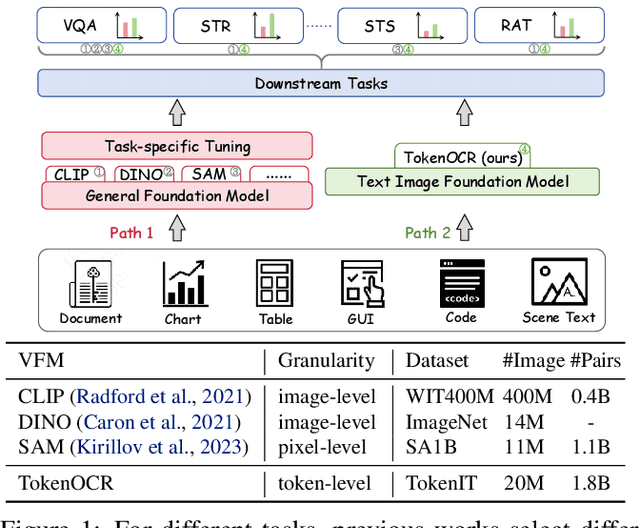
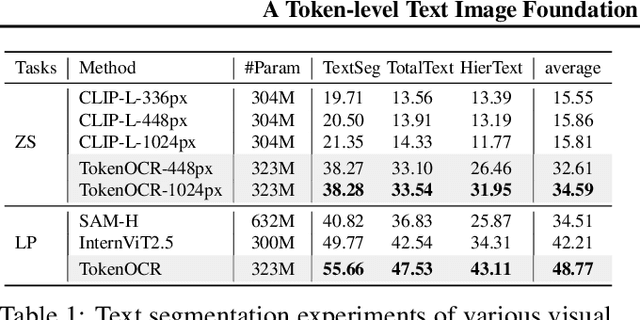
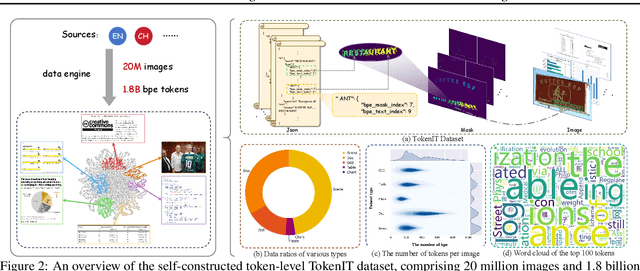

Abstract:In recent years, general visual foundation models (VFMs) have witnessed increasing adoption, particularly as image encoders for popular multi-modal large language models (MLLMs). However, without semantically fine-grained supervision, these models still encounter fundamental prediction errors in the context of downstream text-image-related tasks, i.e., perception, understanding and reasoning with images containing small and dense texts. To bridge this gap, we develop TokenOCR, the first token-level visual foundation model specifically tailored for text-image-related tasks, designed to support a variety of traditional downstream applications. To facilitate the pretraining of TokenOCR, we also devise a high-quality data production pipeline that constructs the first token-level image text dataset, TokenIT, comprising 20 million images and 1.8 billion token-mask pairs. Furthermore, leveraging this foundation with exceptional image-as-text capability, we seamlessly replace previous VFMs with TokenOCR to construct a document-level MLLM, TokenVL, for VQA-based document understanding tasks. Finally, extensive experiments demonstrate the effectiveness of TokenOCR and TokenVL. Code, datasets, and weights will be available at https://token-family.github.io/TokenOCR_project.
Multimodal Large Language Models for Text-rich Image Understanding: A Comprehensive Review
Feb 23, 2025Abstract:The recent emergence of Multi-modal Large Language Models (MLLMs) has introduced a new dimension to the Text-rich Image Understanding (TIU) field, with models demonstrating impressive and inspiring performance. However, their rapid evolution and widespread adoption have made it increasingly challenging to keep up with the latest advancements. To address this, we present a systematic and comprehensive survey to facilitate further research on TIU MLLMs. Initially, we outline the timeline, architecture, and pipeline of nearly all TIU MLLMs. Then, we review the performance of selected models on mainstream benchmarks. Finally, we explore promising directions, challenges, and limitations within the field.
CharGen: High Accurate Character-Level Visual Text Generation Model with MultiModal Encoder
Dec 23, 2024Abstract:Recently, significant advancements have been made in diffusion-based visual text generation models. Although the effectiveness of these methods in visual text rendering is rapidly improving, they still encounter challenges such as inaccurate characters and strokes when rendering complex visual text. In this paper, we propose CharGen, a highly accurate character-level visual text generation and editing model. Specifically, CharGen employs a character-level multimodal encoder that not only extracts character-level text embeddings but also encodes glyph images character by character. This enables it to capture fine-grained cross-modality features more effectively. Additionally, we introduce a new perceptual loss in CharGen to enhance character shape supervision and address the issue of inaccurate strokes in generated text. It is worth mentioning that CharGen can be integrated into existing diffusion models to generate visual text with high accuracy. CharGen significantly improves text rendering accuracy, outperforming recent methods in public benchmarks such as AnyText-benchmark and MARIO-Eval, with improvements of more than 8% and 6%, respectively. Notably, CharGen achieved a 5.5% increase in accuracy on Chinese test sets.
InstructOCR: Instruction Boosting Scene Text Spotting
Dec 20, 2024Abstract:In the field of scene text spotting, previous OCR methods primarily relied on image encoders and pre-trained text information, but they often overlooked the advantages of incorporating human language instructions. To address this gap, we propose InstructOCR, an innovative instruction-based scene text spotting model that leverages human language instructions to enhance the understanding of text within images. Our framework employs both text and image encoders during training and inference, along with instructions meticulously designed based on text attributes. This approach enables the model to interpret text more accurately and flexibly. Extensive experiments demonstrate the effectiveness of our model and we achieve state-of-the-art results on widely used benchmarks. Furthermore, the proposed framework can be seamlessly applied to scene text VQA tasks. By leveraging instruction strategies during pre-training, the performance on downstream VQA tasks can be significantly improved, with a 2.6% increase on the TextVQA dataset and a 2.1% increase on the ST-VQA dataset. These experimental results provide insights into the benefits of incorporating human language instructions for OCR-related tasks.
ODM: A Text-Image Further Alignment Pre-training Approach for Scene Text Detection and Spotting
Mar 01, 2024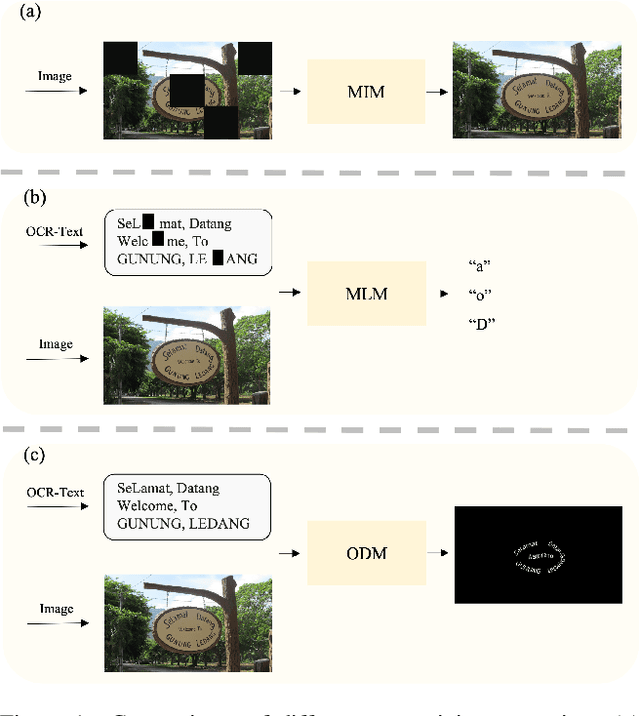

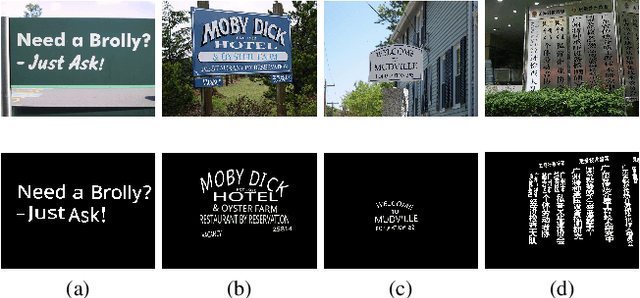

Abstract:In recent years, text-image joint pre-training techniques have shown promising results in various tasks. However, in Optical Character Recognition (OCR) tasks, aligning text instances with their corresponding text regions in images poses a challenge, as it requires effective alignment between text and OCR-Text (referring to the text in images as OCR-Text to distinguish from the text in natural language) rather than a holistic understanding of the overall image content. In this paper, we propose a new pre-training method called OCR-Text Destylization Modeling (ODM) that transfers diverse styles of text found in images to a uniform style based on the text prompt. With ODM, we achieve better alignment between text and OCR-Text and enable pre-trained models to adapt to the complex and diverse styles of scene text detection and spotting tasks. Additionally, we have designed a new labeling generation method specifically for ODM and combined it with our proposed Text-Controller module to address the challenge of annotation costs in OCR tasks, allowing a larger amount of unlabeled data to participate in pre-training. Extensive experiments on multiple public datasets demonstrate that our method significantly improves performance and outperforms current pre-training methods in scene text detection and spotting tasks. Code is available at {https://github.com/PriNing/ODM}.
VOC-ReID: Vehicle Re-identification based on Vehicle-Orientation-Camera
May 15, 2020
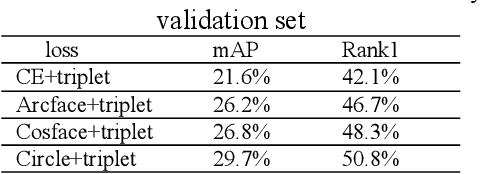
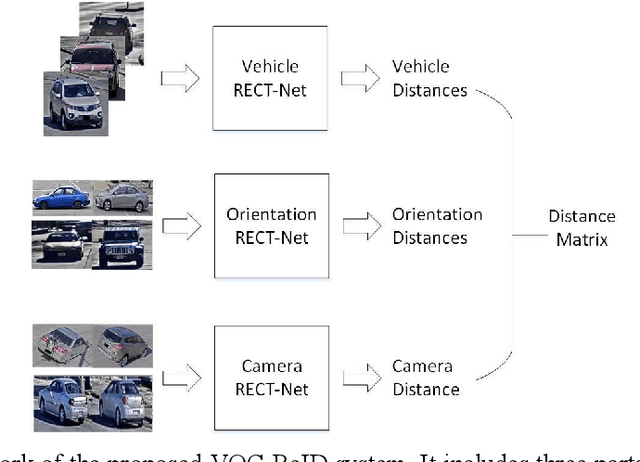

Abstract:Vehicle re-identification is a challenging task due to high intra-class variances and small inter-class variances. In this work, we focus on the failure cases caused by similar background and shape. They pose serve bias on similarity, making it easier to neglect fine-grained information. To reduce the bias, we propose an approach named VOC-ReID, taking the triplet vehicle-orientation-camera as a whole and reforming background/shape similarity as camera/orientation re-identification. At first, we train models for vehicle, orientation and camera re-identification respectively. Then we use orientation and camera similarity as penalty to get final similarity. Besides, we propose a high performance baseline boosted by bag of tricks and weakly supervised data augmentation. Our algorithm achieves the second place in vehicle re-identification at the NVIDIA AI City Challenge 2020.
Deep Residual Text Detection Network for Scene Text
Nov 11, 2017

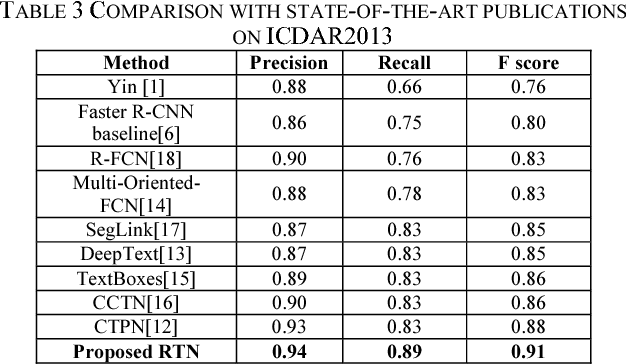
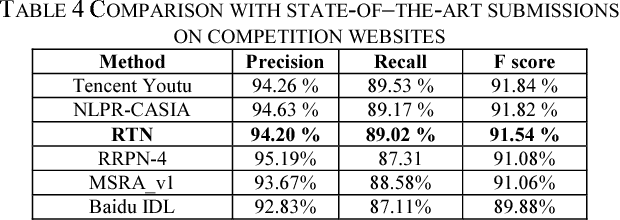
Abstract:Scene text detection is a challenging problem in computer vision. In this paper, we propose a novel text detection network based on prevalent object detection frameworks. In order to obtain stronger semantic feature, we adopt ResNet as feature extraction layers and exploit multi-level feature by combining hierarchical convolutional networks. A vertical proposal mechanism is utilized to avoid proposal classification, while regression layer remains working to improve localization accuracy. Our approach evaluated on ICDAR2013 dataset achieves F-measure of 0.91, which outperforms previous state-of-the-art results in scene text detection.
 Add to Chrome
Add to Chrome Add to Firefox
Add to Firefox Add to Edge
Add to Edge